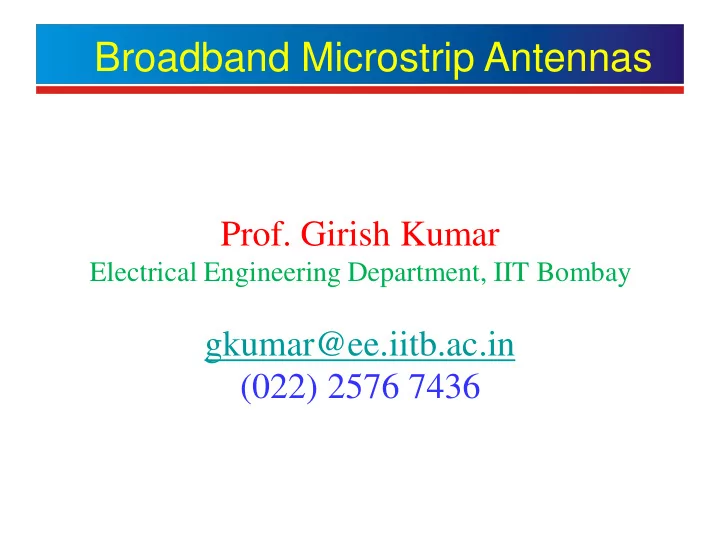

Broadband Microstrip Antennas Prof. Girish Kumar Electrical Engineering Department, IIT Bombay gkumar@ee.iitb.ac.in (022) 2576 7436
MSA – BW Variation with h and f
MSA – Broadband Using Multi-Resonators Broad bandwidth using multi-resonator concept. Two resonators are optimally coupled to obtain broad bandwidth
Two Gap Coupled RMSA L = 3 cm and W = 4 cm, ε r = 2.55 and h = 0.159 cm , L 1 = 2.9 cm, W = 4 cm, s = 0.1 cm and x = 0.7 cm . Gap Coupled RMSA RMSA
Effect of Feed-Point - Two Gap Coupled RMSA x = 0.7 cm x = 1.1 cm As x increases from 0.7 to 1.1 cm, input impedance plot shifts right and the loop is inside VSWR = 2 circle. For x = 1.1 cm, BW for VSWR < 2 is 207 MHz (~7%). This BW is more than three times the BW of a single RMSA.
Effect of Length L 1 - Two Gap Coupled RMSA L 1 : ( - - - ) 2.8, ( —— ) 2.9, and ( – - – ) 3.0 cm As L 1 decreases from 3.0 to 2.8 cm, its resonance frequency increases, so the loop in the input impedance plot shifts towards higher frequency region, i.e. in clockwise direction.
Effect of Gap S - Two Gap Coupled RMSA S : ( - - - ) 0.05, ( – - – ) 0.1, and ( —— ) 0.15 cm. As gap S increases from 0.05 to 0.15 cm, the coupling between the two patches is reduced and hence size of the loop in the input impedance plot reduces.
Radiation Pattern of Two Gap Coupled RMSA L = 3 cm and W = 4 cm, f = 2.9 GHz f = 3.0 GHz ε r = 2.55 and h = 0.159 cm , L 1 = 2.9 cm, W = 4 cm, s = 0.1 cm and x = 1.1 cm . BW for VSWR < 2 is 2.895 to 3.102 GHz In the E-plane, the beam maxima shifts away from the broadside f = 3.1 GHz as frequency increases from Radiation Pattern: ( —— ) E-plane and ( - - - ) H-plane 2.9 to 3.1 GHz.
Three Gap Coupled RMSA – Effect of Gap S L = 3 cm, W = 4 cm, ε r = 2.55 and h = 0.159 cm , L 1 = 2.9 cm, W = 4 cm, and x = 1.1 cm . BW = 209 MHz BW = 171 MHz S : ( – - – ) 0.1, ( - - - ) 0.15, and ( —— ) 0.2 cm
Radiation Pattern of Three Gap Coupled RMSA For S = 0.15 cm, Radiation pattern at (a) 2.89 and (b) 3.09 GHz ( —— ) E-plane and ( - - - ) H-plane. Gain of Three Gap Coupled RMSA is 9.4 dB at 3 GHz, which is 2.7 dB more than the single RMSA.
Three Gap Coupled RMSA – Effect of Length L 1 h = 3.18 mm, ε r = 2.55, L = W = 30 mm, x = 14 mm, s = 3mm, two values of L 1 ( - - - ) 29 mm and ( —— ) 27.5 mm For L 1 = 27.5 mm, the loop is completely inside VSWR = 2 circle yielding BW of 335 MHz (11.3%)
Non-Radiating Edge Gap Coupled RMSA h : ( —— ) 0.159 cm L = 3 cm, W = 4 cm, ε r = 2.55 s = 0.05 cm , L 1 = L 2 = 2.9 cm, W = 4 cm, and x = 1.1 cm . h : ( - - - ) 0.318 cm L = 3 cm, W = 3 cm, ε r = 2.55 s = 0.05 cm , L 1 = L 2 = 2.7 cm, W = 3 cm, and x = 1.4 cm . h : ( —— ) 0.159 cm BW = 159 MHz (5.3%) h : ( - - - ) 0.318 cm BW = 390 MHz (12.7%)
Gap Coupled RMSA Configurations (a) Radiating edges coupled (b) Non-radiating (c) Four edges coupled edges coupled
Four Edges Gap Coupled RMSA ε r = 2.55, h = 3.18 mm, L = W = 30 mm, L 1 = 27.5 mm, s 1 = 2.5 mm, L 2 = 25.5 mm, s 2 = 0.5 mm, x = 14 mm Two loops in Smith chart within VSWR = 2 circle. BW for VSWR < 2 is 569 MHz (18%)
Four Edges Coupled MSA – Radiation Pattern 2.84 GHz 3.12 GHz 3.40 GHz
Directly Coupled RMSA
Gap Coupled Circular MSA
Gap Coupled Semi-Circular MSA BW for VSWR < 2 is 143 MHz at 2.72 GHz, which is more than twice the BW of CMSA on same substrate but gain is not uniform over the bandwidth.
RMSA with U-Slot By cutting a U-slot inside a RMSA, BW is increased without increasing the volume of the antenna. Resonance of U-slot should be close to that of RMSA Disadvantage – gain is not uniform over the bandwidth
Recommend
More recommend